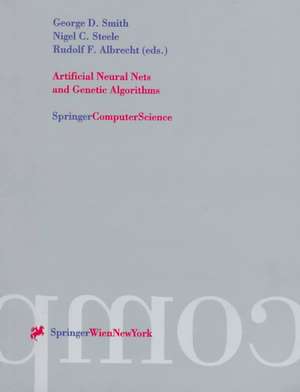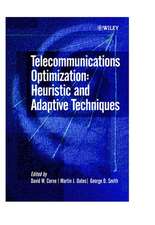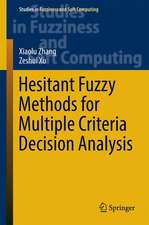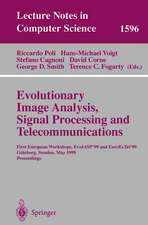Artificial Neural Nets and Genetic Algorithms: Proceedings of the International Conference in Norwich, U.K., 1997
Editat de George D. Smith, Nigel C. Steele, Rudolf F. Albrechten Limba Engleză Paperback – 21 iun 1998
Preț: 371.67 lei
Preț vechi: 464.58 lei
-20% Nou
Puncte Express: 558
Preț estimativ în valută:
71.12€ • 74.45$ • 58.85£
71.12€ • 74.45$ • 58.85£
Carte tipărită la comandă
Livrare economică 05-19 aprilie
Preluare comenzi: 021 569.72.76
Specificații
ISBN-13: 9783211830871
ISBN-10: 3211830871
Pagini: 656
Ilustrații: XVI, 634 p.
Dimensiuni: 210 x 280 x 34 mm
Greutate: 1.5 kg
Ediția:Softcover reprint of the original 1st ed. 1998
Editura: SPRINGER VIENNA
Colecția Springer
Locul publicării:Vienna, Austria
ISBN-10: 3211830871
Pagini: 656
Ilustrații: XVI, 634 p.
Dimensiuni: 210 x 280 x 34 mm
Greutate: 1.5 kg
Ediția:Softcover reprint of the original 1st ed. 1998
Editura: SPRINGER VIENNA
Colecția Springer
Locul publicării:Vienna, Austria
Public țintă
ResearchDescriere
This is the third in a series of conferences devoted primarily to the theory and applications of artificial neural networks and genetic algorithms. The first such event was held in Innsbruck, Austria, in April 1993, the second in Ales, France, in April 1995. We are pleased to host the 1997 event in the mediaeval city of Norwich, England, and to carryon the fine tradition set by its predecessors of providing a relaxed and stimulating environment for both established and emerging researchers working in these and other, related fields. This series of conferences is unique in recognising the relation between the two main themes of artificial neural networks and genetic algorithms, each having its origin in a natural process fundamental to life on earth, and each now well established as a paradigm fundamental to continuing technological development through the solution of complex, industrial, commercial and financial problems. This is well illustrated in this volume by the numerous applications of both paradigms to new and challenging problems. The third key theme of the series, therefore, is the integration of both technologies, either through the use of the genetic algorithm to construct the most effective network architecture for the problem in hand, or, more recently, the use of neural networks as approximate fitness functions for a genetic algorithm searching for good solutions in an 'incomplete' solution space, i.e. one for which the fitness is not easily established for every possible solution instance.
Cuprins
Obstacle Identification by an Ultrasound Sensor Using Neural Networks.- A Modular Reinforcement Learning Architecture for Mobile Robot Control.- Timing without Time — An Experiment in Evolutionary Robotics.- Incremental Acquisition of Complex Behaviour by Structured Evolution.- Evolving Neural Controllers for Robot Manipulators.- Using Genetic Algorithms with Variable-length Individuals for Planning Two-Manipulators Motion.- Ensembles of Neural Networks for Digital Problems.- A Modular Neural Network Architecture with Additional Generalization Abilities for Large Input Vectors.- Principal Components Identify MLP Hidden Layer Size for Optimal Generalisation Performance.- Bernoulli Mixture Model of Experts for Supervised Pattern Classification.- Electric Load Forecasting with Genetic Neural Networks.- Multiobjective Pressurised Water Reactor Reload Core Design Using a Genetic Algorithm.- Using Artificial Neural Networks to Model Non-Linearity in a Complex System.- Transit Time Estimation by Artificial Neural Networks.- Evolving Asynchronous and Scalable Non-uniform Cellular Automata.- One-Chip Evolvable Hardware: 1C-EHW.- Evolving Low-Level Vision Capabilities with the GENCODER Genetic Programming Environment.- NLRFLA: A Supervised Learning Algorithm for the Development of Non-Linear Receptive Fields.- Fuzzy-tuned Stochastic Scanpaths for AGV Vision.- On VLSI Implementation of Multiple Output Sequential Learning Networks.- Automated Parameter Selection for a Computer Simulation of Auditory Nerve Fibre Activity using Genetic Algorithms.- Automatic Extraction of Phase and Frequency Information from Raw Voice Data.- A Speech Recognition System using an Auditory Model and TOM Neural Network.- Fahlman-Type Activation Functions Applied to Nonlinear PCA Networks Provide a Generalised Independent Component Analysis.- Blind Source Separation via Unsupervised Learning.- Neural Networks for Higher-Order Spectral Estimation.- Estimation of Fractal Signals by Wavelets and GAs.- Classification of 3-D Dendritic Spines using Self-Organizing Maps.- Neural Network Analysis of Hue Spectra from Natural Images.- Detecting Small Features in SAR Images by an ANN.- Optimising Handwritten-Character Recognition with Logic Neural Networks.- Combined Neural Network Models for Epidemiological Data: Modelling Heterogeneity and Reduction of Input Correlations.- A Hybrid Expert System Architecture for Medical Diagnosis.- Enhancing Connectionist Expert Systems by IAC Models through Real Cases.- A Schema Theorem-Type Result for Multidimensional Crossover.- Möbius Crossover and Excursion Set Mediated Genetic Algorithms.- The Single Chromosome’s Guide to Dating.- A Fuzzy Taguchi Controller to Improve Genetic Algorithm Parameter Selection.- Walsh Functions and Predicting Problem Complexity.- Migration through Mutation Space: A Means of Accelerating Convergence in Evolutionary Algorithms.- Dual Genetic Algorithms and Pareto Optimization.- Multi-layered Niche Formation.- Using Hierarchical Genetic Populations to Improve Solution Quality.- A Redundant Representation for Use by Genetic Algorithms on Parameter Optimisation Problems.- A Genetic Algorithm for Learning Weights in a Similarity Function.- Learning SCFGs from Corpora by a Genetic Algorithm.- Adaptive Product Optimization and Simultaneous Customer Segmentation: A Hospitality Product Design Study with Genetic Algorithms.- Genetic Algorithm Utilising Neural Network Fitness Evaluation for Musical Composition.- Analyses of Simple Genetic Algorithms and Island Model Parallel Genetic Algorithms.- Supervised Parallel Genetic Algorithms in Aerodynamic Optimisation.- A Genetic Clustering Method for the Multi-Depot Vehicle Routing Problem.- A Hybrid Genetic / Branch and Bound Algorithm for Integer Programming.- Breeding Perturbed City Coordinates and Fooling Travelling Salesman Heuristic Algorithms.- Improvements on the Ant-System: Introducing the MAX-MIN Ant System.- A Hybrid Genetic Algorithm for the 0-1 Multiple Knapsack Problem.- Genetic Algorithms in the Elevator Allocation Problem.- Generational and Steady-State Genetic Algorithms for Generator Maintenance Scheduling Problems.- Four Methods for Maintenance Scheduling.- A Genetic Algorithm for the Generic Crew Scheduling Problem.- Genetic Algorithms and the Timetabling Problem.- Evolutionary Approaches to the Partition/Timetabling Problem.- Discovering Simple Fault-Tolerant Routing Rules by Genetic Programming.- The Ring-Loading and Ring-Sizing Problem.- Evolutionary Computation Techniques for Telephone Networks Traffic Supervision Based on a Qualitative Stream Propagation Model.- NOMaD: Applying a Genetic Algorithm/Heuristic Hybrid Approach to Optical Network Topology Design.- Application of a Genetic Algorithm to the Availability-Cost Optimization of a Transmission Network Topology.- Breeding Permutations for Minimum Span Frequency Assignment.- A Practical Frequency Planning Technique for Cellular Radio.- Chaotic Neurodynamics in the Frequency Assignment Problem.- A Divide-and-Conquer Technique to Solve the Frequency Assignment Problem.- Genetic Algorithm Based Software Testing.- An Evolutionary/Meta-Heuristic Approach to Emergency Resource Redistribution in the Developing World.- Automated Design of Combinational Logic Circuits by Genetic Algorithms.- Forecasting of the Nile River Inflows by Genetic Algorithms.- A Comparative Study of Neural Network Optimization Techniques.- GA-RBF: A Self-Optimising RBF Network.- Canonical Genetic Learning of RBF Networks Is Faster.- The Baldwin Effect on the Evolution of Associative Memory.- Using Embryology as an Alternative to Genetic Algorithms for Designing Artificial Neural Network Topologies.- Empirical Study of the Influences of Genetic Parameters in the Training of a Neural Network.- Evolutionary Optimization of the Structure of Neural Networks by a Recursive Mapping as Encoding.- Using Genetic Engineering To Find Modular Structures for Architectures of Artificial Neural Networks.- Evolutionary Learning of Recurrent Networks by Successive Orthogonal Inverse Approximations.- Evolutionary Optimization of Neural Networks for Reinforcement Learning Algorithms.- Generalising Experience in Reinforcement Learning: Performance in Partially Observable Processes.- Optimal Control of an Inverted Pendulum by Genetic Programming: Practical Aspects.- Evolutionary Artificial Neural Networks and Genetic Programming: A Comparative Study Based on Financial Data.- A Canonical Genetic Algorithm Based Approach to Genetic Programming.- Is Genetic Programming Dependent on High-level Primitives.- DGP: How To Improve Genetic Programming with Duals.- Fitness Landscapes and Inductive Genetic Programming.- Discovery of Symbolic, Neuro-Symbolic and Neural Networks with Parallel Distributed Genetic Programming.- A Neural Network Technique for Detecting and Modelling Residential Property Sub-Markets.- Versatile Graph Planarisation via an Artificial Neural Network.- Artificial Neural Networks for Generic Predictive Maintenance.- The Effect of Recurrent Networks on Policy Improvement in Polling Systems.- EXPRESS — A Strategic Software System for Equity Valuation.- Virtual Table Tennis and the Design of Neural Network Players.- Investigating Arbitration Strategies in an Animat Navigation System.- Sequence Clustering by Time Delay Networks.- Modeling Complex Symbolic Sequences with Neural Based Systems.- An Unsupervised Neural Method for Time Series Analysis, Characterisation and Prediction.- Time-Series Prediction with Neural Networks: Combinatorial versus Sequential Approach.- A New Method for Defining Parameters to SETAR(2;k1,k2)-models.- Predicting Conditional Probability Densities with the Gaussian Mixture-sRVFL Network.- An Artificial Neuron with Quantum Mechanical Properties.- Computation of Weighted Sum by Physical. Wave Properties-Coding Problems by Unit Positions.- Some Analytical Results for a Recurrent Neural Network Producing Oscillations.- Upper Bounds on the Approximation Rates of Real-valued Boolean Functions by Neural Networks.- A Method for Task Allocation in Modular Neural Network with an Information Criterion.- A Meta Neural Network Polling System for the RPROP Learning Rule.- Designing Development Rules for Artificial Evolution.- Improved Center Point Selection for Probabilistic Neural Networks.- The Evolution of a Feedforward Neural Network trained under Backpropagation.- Fuzzy Vector Bundles for Classification via Neural Networks.- A Constructive Algorithm for Real Valued Multi-category Classification Problems.- Classification of Thermal Profiles in Blast Furnace Walls by Neural Networks.- Geometrical Selection of Important Inputs with Feedforward Neural Networks.- Classifier Systems Based on Possibility Distributions: A Comparative Study.- Learning by Co-operation: Combining Multiple Computationally Intelligent Programs into a Computational Network.- Comparing a Variety of Evolutionary Algorithm Techniques on a Collection of Rule Induction Tasks.- An Investigation into the Performance and Representations of a Stochastic, Evolutionary Neural Tree.- Experimental Results of a Michigan-like Evolution Strategy for Non-stationary Clustering.- Excursion Set Mediated Evolutionary Strategy.- Use of Mutual Information to Extract Rules from Artificial Neural Networks.- Connectionism and Symbolism in Symbiosis.- Genetic Design of Robust PID Controllers.- Coevolutionary Process Control.- Cooperative Coevolution in Inventory Control Optimisation.- Dynamic Neural Nets in the State Space Utilized in Non-Linear Process Identification.- Distal Learning for Inverse Modeling of Dynamical Systems.- Genetic Algorithms in Structure Identification for NARX Models.- A Model-based Neural Network Controller for a Process Trainer Laboratory Equipment.- MIMO Fuzzy Logic Control of a Liquid Level Process.- A Practical Application of a Learning Classifier System in a Steel Hot Strip Mill.- Muiti-Agent Classifier Systems and the Iterated Prisoner’s Dilemma.- Complexity Cost and Two Types of Noise in the Repeated Prisoner’s Dilemma.- Workshop Summary.- Plenary Lectures.
Caracteristici
State-of-the-art in this field

























